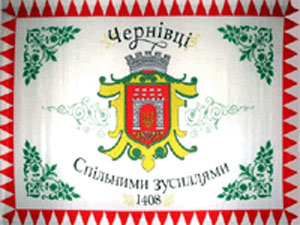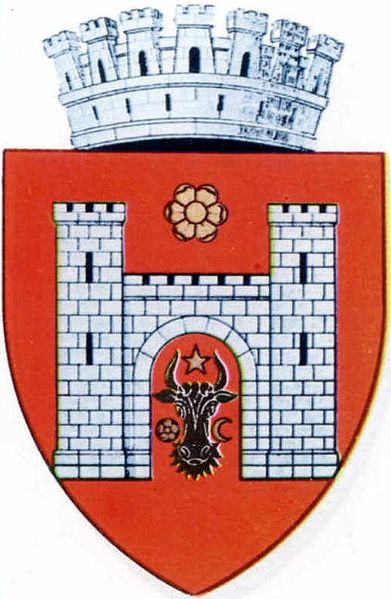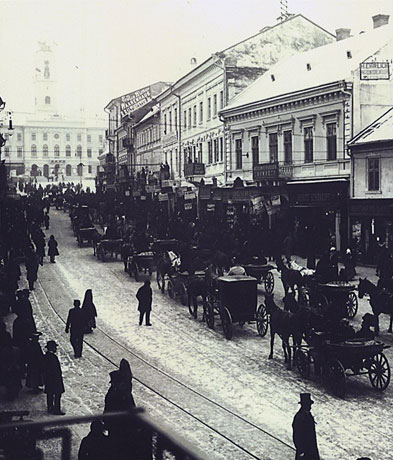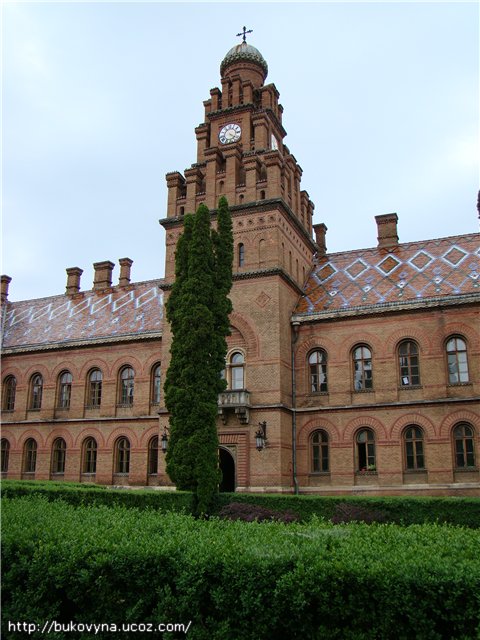CHERNIVTSI
Chernivtsi coat of arms 

Flag of Chernivtsi
Chernivtsi (Ukrainian: Чернівці; German: Czernowitz; Romanian: Cernăuţi; Russian: Черновцы; see also other names) is the administrative center of Chernivtsi Oblast (province) in western Ukraine. The city is situated on the upper course of the River Prut, a tributary of the Danube, in the northern part of historic region of Bukovina, which is currently divided between Romania and Ukraine. At the time of the 2001 Ukrainian Census, the population of the city was 240,600.
Many well-known historical figures were born in the city, including poets and writers Paul Celan, Alfred Kittner, the former Speaker of the Parliament Arseniy Yatsenyuk, the Vienna Secession artist Oskar Laske, physicist Radu Grigorovici, Maria Forescu. Many other famous people lived and worked in the city, such as Ukrainian national poets Ivan Franko and Yuriy Fedkovych, the first President of Ukraine Leonid Kravchuk, Romanian national poet Mihai Eminescu, Eudoxiu Hurmuzachi, Aron Pumnul, Ciprian Porumbescu, Sextil Puşcariu, Ion Nistor, Gala Galaction, Joseph Schumpeter, Nikolai Vavilov, Abraham Goldfaden, Avigdor Arikha, and Aharon Appelfeld.
Together with the city of Lviv, Chernivtsi is viewed at present to be a cultural centre of Western Ukraine. The city is also considered one of modern Ukraine's greatest cultural and educational centers. Historically, as a cultural and architectural center, Chernivtsi was even named Little Vienna, Small Paris, Jerusalem upon the Prut, or the European Alexandria. Chernivtsi is currently twinned with seven other cities around the world. The city is also a major point of railway and highway crossings in the region, and houses an international airport.
Name
Aside from Ukrainian, Chernivtsi is also known by many different foreign names, which were used during times of rule by different coutries throughout the city's history, or by the respective population groups at the time: Romanian: Cernăuţi; German: Czernowitz; Yiddish: טשערנאוויץ, translit. Tshernovits; Polish: Czerniowce; Hungarian: Csernovic, Russian: Черновцы́, translit. Chernovtsy (until 1944: Чернови́цы, translit. Chernovitsy). In the times of Halych-Volyn Principality the city's name was Chern.

A tourist info plaque showing the name Chernivtsi written in 10 languages (click to enlarge)
Geography
Chernivtsi is located in the historic region of Bukovina, which is currently shared between Romania (south) and Ukraine (north). The city lies 248 meters above sea level, and is surrounded by forests and fields. The River Prut runs through the city's landscape.
History
Chernivtsi continues to hold a prominent position among other cities in Ukraine and Eastern Europe. The city's ancient beginnings and significant history add to its charm and attraction for those interested in Bukovyna.

Chernivtsi coat of arms in 1918–1940
Archeological evidence discovered in the area surrounding Chernivtsi indicates that a local population inhabited it since the neolithic era. Later settlements included those of the Cucuteni-Trypillian culture, the Corded Ware culture; artifacts from the Bronze and Iron Ages were also found in the city.
Remains of the early Slavic tribes in the area date back to the 2nd–5th centuries, with the artifacts of Chroatian and Tiverian peoples from the 9th–11th centuries also being present. A fortified settlement located on the left (north-eastern) shore of Prut dates back to the time of the Principality of Halych and is thought to have been built by Grand Prince Yaroslav Osmomysl. Legendary accounts refer to this fortress-city as Chern’, or Black city; it is said to owe its name to the black color of the city walls, built from dark oak layered with local black-colored soil. This early stronghold was destroyed during the Mongol invasion of Europe by the Burundai in 1259. However, the remaining ramparts of the fortress were still used for defense purposes; in the 17th century they were augmented with several bastions, one of which is still extant.
Following the destruction of the fortress, later settlements in the area centered on the right (south-western) shore of the Prut River, at a more strategically advantageous, elevated location. In 1325, when Kingdom of Poland took over Galicia, and came into contact with the early Vlach (Romanian) feodal formations, a fort was mentioned under the name Ţeţina; it was defending the ford and crossing point on the Prut River. It was part of a group of three fortifications, the other two being the fortress of Hotin on the Dniester to the east, and a fort on the Kolachin River, a upriver tributary of Prut.
Between 1359 and 1775, the city and its surroundings were part of the Principality of Moldavia; the city being the administrative center of the homonymous ţinut (county).The name Cernăuţi/Chernivtsi is first attested in a document by Alexander the Good on October 8, 1408. In Ottoman sources, the city was mentioned as "Çernovi".
In 1775, around 1/10 of the territory of Moldavia was annexed by the Austrian Empire; this region became known as Bukovina. The city became the region's capital, which in 1849 was raised in status and became known as the Duchy of Bukovina, a crownland of the Austrian Empire. The city received Magdeburg rights. The city began to flourish in 1778 when Knight Karl von Enzenberg was appointed the chief of the Military Administration. He invited many merchants, craftsmen and entrepreneurs to help develop trade and other businesses. Saint Peter's Fairs (July 1-15) had given a new vibrant impulse to the market development from 1786.
During the 19th and early 20th century, Chernivtsi became a center of both Romanian and Ukrainian national movements. It was also the site of the first Yiddish language conference in 1908, coordinated by Nathan Birnbaum. When Austria-Hungary dissolved in 1918, the city and its surrounding area became a part of the Kingdom of Romania. In 1930, the city reached a population of 112,400; 26.8% Jews, 23.2% Romanians, 20.8% Germans, 18.6% Ukrainians, the remainder Poles and others. It was one of the five university centers of the inter-war Romania.
 | So Chernivtsi looked in the end XIX century |
In 1940, the Red Army took control over the area; the area around the city became known as Chernivtsi Oblast, and was allotted to the Ukrainian SSR by the Soviet Union. In July 1941, Romanian Army re-took the city as part of the Axis attack on the Soviet Union during World War II. In 1944, when Axis forces were driven out by the Red Army, the city was re-incorporated in the Ukrainian SSR. The city became a predominantly Ukrainian one.
Since 1991, Chernitvtsi has been a part of the independent Ukraine. In May 1999, Romania opened a consulate general in the city. Contemporary Chernivtsi is an important regional center, which is situated on the picturesque banks of Prut River and occupies an area of about 150 square kilometres (58 sq mi).
Government and administrative divisions
Chernivtsi is the administrative center of Chernivtsi Oblast (province), as well as of the Chernivtsi City Municipality housed within the city. However, Chernivtsi is a city of oblast subordinance, thus being subject directly to the oblast authorities rather to the city municipality housed in the city itself.[clarification needed]
The territory of Chernivtsi is divided into 3 administrative districts:
- Pershotravnevyi Raion (Ukrainian: Першотравневий район)
- Sadhirskyi Raion (Ukrainian: Садгірський район)
- Shevchenkivskyi Raion (Ukrainian: Шевченківський район)
The mayor of Chernivtsi is Mykola Fedoruk, who has held the position since 1994.
See also:
 | Streets and squares in Chernivtsi |
 | Architecture in Chernivtsi |
 | Cathedrals and churches in Chernivtsi |
 | Monuments in Chernivtsi |
 | Museums in Chernivtsi |
CHERNIVTSI FROM THE SPACE
